
- •About the Author
- •About the Technical Editor
- •Credits
- •Is This Book for You?
- •Software Versions
- •Conventions This Book Uses
- •What the Icons Mean
- •How This Book Is Organized
- •How to Use This Book
- •What’s on the Companion CD
- •What Is Excel Good For?
- •What’s New in Excel 2010?
- •Moving around a Worksheet
- •Introducing the Ribbon
- •Using Shortcut Menus
- •Customizing Your Quick Access Toolbar
- •Working with Dialog Boxes
- •Using the Task Pane
- •Creating Your First Excel Worksheet
- •Entering Text and Values into Your Worksheets
- •Entering Dates and Times into Your Worksheets
- •Modifying Cell Contents
- •Applying Number Formatting
- •Controlling the Worksheet View
- •Working with Rows and Columns
- •Understanding Cells and Ranges
- •Copying or Moving Ranges
- •Using Names to Work with Ranges
- •Adding Comments to Cells
- •What Is a Table?
- •Creating a Table
- •Changing the Look of a Table
- •Working with Tables
- •Getting to Know the Formatting Tools
- •Changing Text Alignment
- •Using Colors and Shading
- •Adding Borders and Lines
- •Adding a Background Image to a Worksheet
- •Using Named Styles for Easier Formatting
- •Understanding Document Themes
- •Creating a New Workbook
- •Opening an Existing Workbook
- •Saving a Workbook
- •Using AutoRecover
- •Specifying a Password
- •Organizing Your Files
- •Other Workbook Info Options
- •Closing Workbooks
- •Safeguarding Your Work
- •Excel File Compatibility
- •Exploring Excel Templates
- •Understanding Custom Excel Templates
- •Printing with One Click
- •Changing Your Page View
- •Adjusting Common Page Setup Settings
- •Adding a Header or Footer to Your Reports
- •Copying Page Setup Settings across Sheets
- •Preventing Certain Cells from Being Printed
- •Preventing Objects from Being Printed
- •Creating Custom Views of Your Worksheet
- •Understanding Formula Basics
- •Entering Formulas into Your Worksheets
- •Editing Formulas
- •Using Cell References in Formulas
- •Using Formulas in Tables
- •Correcting Common Formula Errors
- •Using Advanced Naming Techniques
- •Tips for Working with Formulas
- •A Few Words about Text
- •Text Functions
- •Advanced Text Formulas
- •Date-Related Worksheet Functions
- •Time-Related Functions
- •Basic Counting Formulas
- •Advanced Counting Formulas
- •Summing Formulas
- •Conditional Sums Using a Single Criterion
- •Conditional Sums Using Multiple Criteria
- •Introducing Lookup Formulas
- •Functions Relevant to Lookups
- •Basic Lookup Formulas
- •Specialized Lookup Formulas
- •The Time Value of Money
- •Loan Calculations
- •Investment Calculations
- •Depreciation Calculations
- •Understanding Array Formulas
- •Understanding the Dimensions of an Array
- •Naming Array Constants
- •Working with Array Formulas
- •Using Multicell Array Formulas
- •Using Single-Cell Array Formulas
- •Working with Multicell Array Formulas
- •What Is a Chart?
- •Understanding How Excel Handles Charts
- •Creating a Chart
- •Working with Charts
- •Understanding Chart Types
- •Learning More
- •Selecting Chart Elements
- •User Interface Choices for Modifying Chart Elements
- •Modifying the Chart Area
- •Modifying the Plot Area
- •Working with Chart Titles
- •Working with a Legend
- •Working with Gridlines
- •Modifying the Axes
- •Working with Data Series
- •Creating Chart Templates
- •Learning Some Chart-Making Tricks
- •About Conditional Formatting
- •Specifying Conditional Formatting
- •Conditional Formats That Use Graphics
- •Creating Formula-Based Rules
- •Working with Conditional Formats
- •Sparkline Types
- •Creating Sparklines
- •Customizing Sparklines
- •Specifying a Date Axis
- •Auto-Updating Sparklines
- •Displaying a Sparkline for a Dynamic Range
- •Using Shapes
- •Using SmartArt
- •Using WordArt
- •Working with Other Graphic Types
- •Using the Equation Editor
- •Customizing the Ribbon
- •About Number Formatting
- •Creating a Custom Number Format
- •Custom Number Format Examples
- •About Data Validation
- •Specifying Validation Criteria
- •Types of Validation Criteria You Can Apply
- •Creating a Drop-Down List
- •Using Formulas for Data Validation Rules
- •Understanding Cell References
- •Data Validation Formula Examples
- •Introducing Worksheet Outlines
- •Creating an Outline
- •Working with Outlines
- •Linking Workbooks
- •Creating External Reference Formulas
- •Working with External Reference Formulas
- •Consolidating Worksheets
- •Understanding the Different Web Formats
- •Opening an HTML File
- •Working with Hyperlinks
- •Using Web Queries
- •Other Internet-Related Features
- •Copying and Pasting
- •Copying from Excel to Word
- •Embedding Objects in a Worksheet
- •Using Excel on a Network
- •Understanding File Reservations
- •Sharing Workbooks
- •Tracking Workbook Changes
- •Types of Protection
- •Protecting a Worksheet
- •Protecting a Workbook
- •VB Project Protection
- •Related Topics
- •Using Excel Auditing Tools
- •Searching and Replacing
- •Spell Checking Your Worksheets
- •Using AutoCorrect
- •Understanding External Database Files
- •Importing Access Tables
- •Retrieving Data with Query: An Example
- •Working with Data Returned by Query
- •Using Query without the Wizard
- •Learning More about Query
- •About Pivot Tables
- •Creating a Pivot Table
- •More Pivot Table Examples
- •Learning More
- •Working with Non-Numeric Data
- •Grouping Pivot Table Items
- •Creating a Frequency Distribution
- •Filtering Pivot Tables with Slicers
- •Referencing Cells within a Pivot Table
- •Creating Pivot Charts
- •Another Pivot Table Example
- •Producing a Report with a Pivot Table
- •A What-If Example
- •Types of What-If Analyses
- •Manual What-If Analysis
- •Creating Data Tables
- •Using Scenario Manager
- •What-If Analysis, in Reverse
- •Single-Cell Goal Seeking
- •Introducing Solver
- •Solver Examples
- •Installing the Analysis ToolPak Add-in
- •Using the Analysis Tools
- •Introducing the Analysis ToolPak Tools
- •Introducing VBA Macros
- •Displaying the Developer Tab
- •About Macro Security
- •Saving Workbooks That Contain Macros
- •Two Types of VBA Macros
- •Creating VBA Macros
- •Learning More
- •Overview of VBA Functions
- •An Introductory Example
- •About Function Procedures
- •Executing Function Procedures
- •Function Procedure Arguments
- •Debugging Custom Functions
- •Inserting Custom Functions
- •Learning More
- •Why Create UserForms?
- •UserForm Alternatives
- •Creating UserForms: An Overview
- •A UserForm Example
- •Another UserForm Example
- •More on Creating UserForms
- •Learning More
- •Why Use Controls on a Worksheet?
- •Using Controls
- •Reviewing the Available ActiveX Controls
- •Understanding Events
- •Entering Event-Handler VBA Code
- •Using Workbook-Level Events
- •Working with Worksheet Events
- •Using Non-Object Events
- •Working with Ranges
- •Working with Workbooks
- •Working with Charts
- •VBA Speed Tips
- •What Is an Add-In?
- •Working with Add-Ins
- •Why Create Add-Ins?
- •Creating Add-Ins
- •An Add-In Example
- •System Requirements
- •Using the CD
- •What’s on the CD
- •Troubleshooting
- •The Excel Help System
- •Microsoft Technical Support
- •Internet Newsgroups
- •Internet Web sites
- •End-User License Agreement
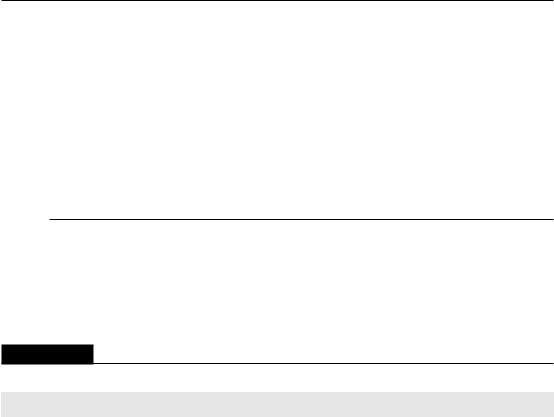
Part II: Working with Formulas and Functions
Determining a date’s quarter
For financial reports, you may find it useful to present information in terms of quarters. The following formula returns an integer between 1 and 4 that corresponds to the calendar quarter for the date in cell A1:
=ROUNDUP(MONTH(A1)/3,0)
This formula divides the month number by 3 and then rounds up the result.
Time-Related Functions
Excel also includes a number of functions that enable you to work with time values in your formulas. This section contains examples that demonstrate the use of these functions.
Table 12.5 summarizes the time-related functions available in Excel. These functions work with date serial numbers. When you use the Insert Function dialog box, these functions appear in the Date & Time function category.
TABLE 12.5
|
Time-Related Functions |
Function |
Description |
|
|
HOUR |
Returns the hour part of a serial number |
|
|
MINUTE |
Returns the minute part of a serial number |
|
|
NOW |
Returns the serial number of the current date and time |
|
|
SECOND |
Returns the second part of a serial number |
|
|
TIME |
Returns the serial number of a specified time |
|
|
TIMEVALUE |
Converts a time in the form of text to a serial number |
|
|
Displaying the current time
This formula displays the current time as a time serial number (or as a serial number without an associated date):
=NOW()-TODAY()
You need to format the cell with a time format to view the result as a recognizable time. The quickest way is to choose Home Number Format Number and select Time from the drop-down list.
272

Chapter 12: Working with Dates and Times
Note
This formula is updated only when the worksheet is calculated. n
Tip
To enter a time stamp (that doesn’t change) into a cell, press Ctrl+Shift+: (colon). n
Displaying any time
One way to enter a time value into a cell is to just type it, making sure that you include at least one colon (:). You can also create a time by using the TIME function. For example, the following formula returns a time comprising of the hour in cell A1, the minute in cell B1, and the second in cell C1:
=TIME(A1,B1,C1)
Like the DATE function, the TIME function accepts invalid arguments and adjusts the result accordingly. For example, the following formula uses 80 as the minute argument and returns 10:20:15 AM. The 80 minutes are simply added to the hour, with 20 minutes remaining.
=TIME(9,80,15)
Caution
If you enter a value greater than 24 as the first argument for the TIME function, the result may not be what you expect. Logically, a formula such as the one that follows should produce a date/time serial number of 1.041667 (that is, one day and one hour).
=TIME(25,0,0)
In fact, this formula is equivalent to the following:
=TIME(1,0,0)
You can also use the DATE function along with the TIME function in a single cell. The formula that follows generates a date and time with a serial number of 39420.7708333333 — which represents 6:30 PM on December 4, 2010:
=DATE(2010,12,4)+TIME(18,30,0)
The TIMEVALUE function converts a text string that looks like a time into a time serial number. This formula returns 0.2395833333, the time serial number for 5:45 AM:
=TIMEVALUE(“5:45 am”)
To view the result of this formula as a time, you need to apply number formatting to the cell. The TIMEVALUE function doesn’t recognize all common time formats. For example, the following formula returns an error because Excel doesn’t like the periods in “a.m.”
=TIMEVALUE(“5:45 a.m.”)
273
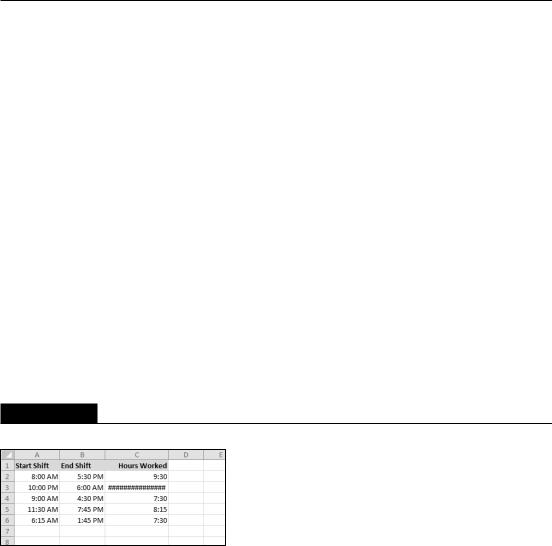
Part II: Working with Formulas and Functions
Calculating the difference between two times
Because times are represented as serial numbers, you can subtract the earlier time from the later time to get the difference. For example, if cell A2 contains 5:30:00 and cell B2 contains 14:00:00, the following formula returns 08:30:00 (a difference of 8 hours and 30 minutes):
=B2-A2
If the subtraction results in a negative value, however, it becomes an invalid time; Excel displays a series of hash marks (#######) because a time without a date has a date serial number of 0. A negative time results in a negative serial number, which cannot be displayed — although you can still use the calculated value in other formulas.
If the direction of the time difference doesn’t matter, you can use the ABS function to return the absolute value of the difference:
=ABS(B2-A2)
This “negative time” problem often occurs when calculating an elapsed time — for example, calculating the number of hours worked given a start time and an end time. This presents no problem if the two times fall in the same day. But if the work shift spans midnight, the result is an invalid negative time. For example, you may start work at 10:00 p.m. and end work at 6:00 a.m. the next day. Figure 12.7 shows a worksheet that calculates the hours worked. As you can see, the shift that spans midnight presents a problem (cell C3).
FIGURE 12.7
Calculating the number of hours worked returns an error if the shift spans midnight.
Using the ABS function (to calculate the absolute value) isn’t an option in this case because it returns the wrong result (16 hours). The following formula, however, does work:
=IF(B2<A2,B2+1,B2)-A2
274

Chapter 12: Working with Dates and Times
Tip
Negative times are permitted if the workbook uses the 1904 date system. To switch to the 1904 date system, use the Advanced section of the Excel Options dialog box. Select the Use 1904 Date System option. But beware! When changing the workbook’s date system, if the workbook uses dates, the dates will be off by four years For more information about the 1904 date system, see the sidebar “Choose Your Date System: 1900 or 1904,” earlier in this chapter. n
Summing times that exceed 24 hours
Many people are surprised to discover that when you sum a series of times that exceed 24 hours, Excel doesn’t display the correct total. Figure 12.8 shows an example. The range B2:B8 contains times that represent the hours and minutes worked each day. The formula in cell B9 is
=SUM(B2:B8)
As you can see, the formula returns a seemingly incorrect total (17 hours, 45 minutes). The total should read 41 hours, 45 minutes. The problem is that the formula is displaying the total as a date/ time serial number of 1.7395833, but the cell formatting is not displaying the date part of the date/ time. The answer is incorrect because cell B9 has the wrong number format.
FIGURE 12.8
Incorrect cell formatting makes the total appear incorrectly.
To view a time that exceeds 24 hours, you need to apply a custom number format for the cell so that square brackets surround the hour part of the format string. Applying the number format here to cell B9 displays the sum correctly:
[h]:mm
Cross-Reference
For more information about custom number formats, see Chapter 24. n
275
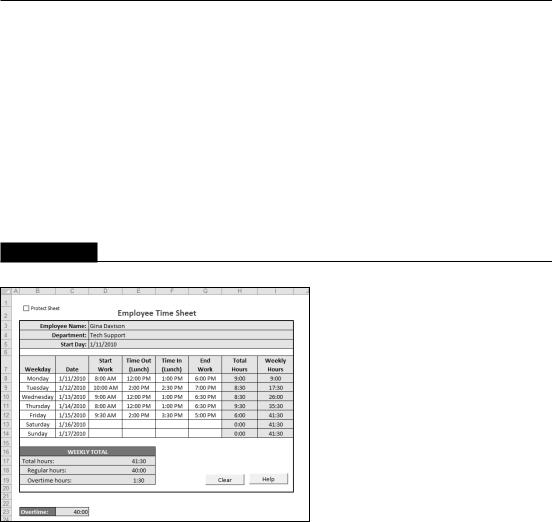
Part II: Working with Formulas and Functions
Figure 12.9 shows another example of a worksheet that manipulates times. This worksheet keeps track of hours worked during a week (regular hours and overtime hours).
On the CD
This workbook is available on the companion CD-ROM. The filename is time sheet.xlsm. The workbook contains a few macros to make it easier to use. n
The week’s starting date appears in cell D5, and the formulas in column B fill in the dates for the days of the week. Times appear in the range D8:G14, and formulas in column H calculate the number of hours worked each day. For example, the formula in cell H8 is
=IF(E8<D8,E8+1-D8,E8-D8)+IF(G8<F8,G8+1-G8,G8-F8)
FIGURE 12.9
An employee timesheet workbook.
The first part of this formula subtracts the time in column D from the time in column E to get the total hours worked before lunch. The second part subtracts the time in column F from the time in column G to get the total hours worked after lunch. I use IF functions to accommodate graveyard shift cases that span midnight — for example, an employee may start work at 10:00 PM and begin lunch at 2:00 AM. Without the IF function, the formula returns a negative result.
The following formula in cell H17 calculates the weekly total by summing the daily totals in column H:
=SUM(H8:H14)
276

Chapter 12: Working with Dates and Times
This worksheet assumes that hours in excess of 40 hours in a week are considered overtime hours. The worksheet contains a cell named Overtime, in cell C23. This cell contains a formula that returns 40:00. If your standard workweek consists of something other than 40 hours, you can change this cell.
The following formula (in cell H18) calculates regular (nonovertime) hours. This formula returns the smaller of two values: the total hours or the overtime hours.
=MIN(E17,Overtime)
The final formula, in cell H19, simply subtracts the regular hours from the total hours to yield the overtime hours.
=E17-E18
The times in H17:H19 may display time values that exceed 24 hours, so these cells use a custom number format:
[h]:mm
Converting from military time
Military time is expressed as a four-digit number from 0000 to 2359. For example, 1:00 a.m. is expressed as 0100 hours, and 3:30 p.m. is expressed as 1530 hours. The following formula converts such a number (assumed to be in cell A1) to a standard time:
=TIMEVALUE(LEFT(A1,2)&”:”&RIGHT(A1,2))
The formula returns an incorrect result if the contents of cell A1 do not contain four digits. The following formula corrects the problem, and it returns a valid time for any military time value from
0 to 2359:
=TIMEVALUE(LEFT(TEXT(A1,”0000”),2)&”:”&RIGHT(A1,2))
Following is a simpler formula that uses the TEXT function to return a formatted string, and then it uses the TIMEVALUE function to express the result in terms of a time.
=TIMEVALUE(TEXT(A1,”00\:00”))
Converting decimal hours, minutes, or seconds to a time
To convert decimal hours to a time, divide the decimal hours by 24. For example, if cell A1 contains 9.25 (representing hours), this formula returns 09:15:00 (nine hours, 15 minutes):
=A1/24
277
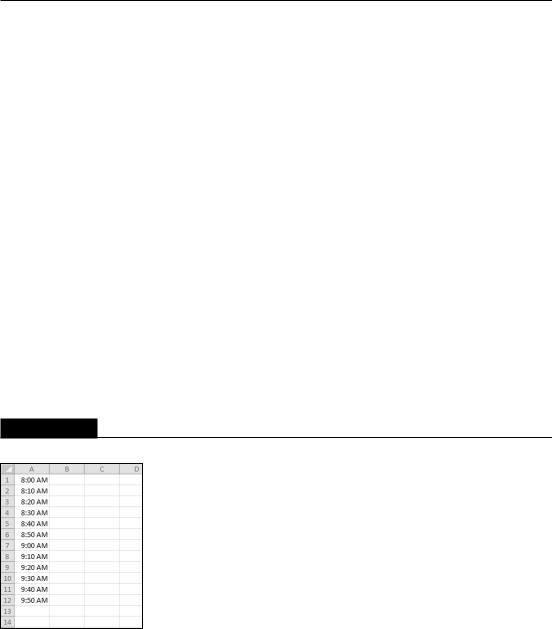
Part II: Working with Formulas and Functions
To convert decimal minutes to a time, divide the decimal hours by 1,440 (the number of minutes in a day). For example, if cell A1 contains 500 (representing minutes), the following formula returns 08:20:00 (eight hours, 20 minutes):
=A1/1440
To convert decimal seconds to a time, divide the decimal hours by 86,400 (the number of seconds in a day). For example, if cell A1 contains 65,000 (representing seconds), the following formula returns 18:03:20 (18 hours, three minutes, and 20 seconds):
=A1/86400
Adding hours, minutes, or seconds to a time
You can use the TIME function to add any number of hours, minutes, or seconds to a time. For example, assume that cell A1 contains a time. The following formula adds 2 hours and 30 minutes to that time and displays the result:
=A1+TIME(2,30,0)
You can use the TIME function to fill a range of cells with incremental times. Figure 12.10 shows a worksheet with a series of times in 10-minute increments. Cell A1 contains a time that was entered directly. Cell A2 contains the following formula, which copied down the column:
=A1+TIME(0,10,0)
FIGURE 12.10
Using a formula to create a series of incremental times.
278

Chapter 12: Working with Dates and Times
Rounding time values
You may need to create a formula that rounds a time to a particular value. For example, you may need to enter your company’s time records rounded to the nearest 15 minutes. This section presents examples of various ways to round a time value.
The following formula rounds the time in cell A1 to the nearest minute:
=ROUND(A1*1440,0)/1440
The formula works by multiplying the time by 1440 (to get total minutes). This value is passed to the ROUND function, and the result is divided by 1440. For example, if cell A1 contains 11:52:34, the formula returns 11:53:00.
The following formula resembles this example, except that it rounds the time in cell A1 to the nearest hour:
=ROUND(A1*24,0)/24
If cell A1 contains 5:21:31, the formula returns 5:00:00.
The following formula rounds the time in cell A1 to the nearest 15 minutes (a quarter of an hour):
=ROUND(A1*24/0.25,0)*(0.25/24)
In this formula, 0.25 represents the fractional hour. To round a time to the nearest 30 minutes, change 0.25 to 0.5, as in the following formula:
=ROUND(A1*24/0.5,0)*(0.5/24)
Working with non–time-of-day values
Sometimes, you may want to work with time values that don’t represent an actual time of day. For example, you may want to create a list of the finish times for a race or record the amount of time you spend in meetings each day. Such times don’t represent a time of day. Rather, a value represents the time for an event (in hours, minutes, and seconds). The time to complete a test, for example, may be 35 minutes and 45 seconds. You can enter that value into a cell as:
00:35:45
Excel interprets such an entry as 12:35:45 a.m., which works fine. (Just make sure that you format the cell so that it appears as you like.) When you enter such times that do not have an hour component, you must include at least one zero for the hour. If you omit a leading zero for a missing hour, Excel interprets your entry as 35 hours and 45 minutes.
279
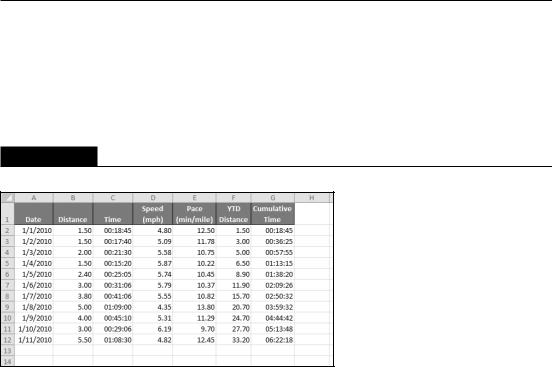
Part II: Working with Formulas and Functions
Figure 12.11 shows an example of a worksheet set up to keep track of a person’s jogging activity. Column A contains simple dates. Column B contains the distance in miles. Column C contains the time it took to run the distance. Column D contains formulas to calculate the speed in miles per hour. For example, the formula in cell D2 is
=B2/(C2*24)
FIGURE 12.11
This worksheet uses times not associated with a time of day.
Column E contains formulas to calculate the pace, in minutes per mile. For example, the formula in cell E2 is
=(C2*60*24)/B2
Columns F and G contain formulas that calculate the year-to-date distance (using column B) and the cumulative time (using column C). The cells in column G are formatted using the following number format (which permits time displays that exceed 24 hours):
[hh]:mm:ss
On the CD
You can also access the workbook shown in Figure 12.11 on the companion CD-ROM. The file is named jogging log.xlsx.
280

CHAPTER
Creating Formulas
That Count and Sum
Many of the most common spreadsheet questions involve counting and summing values and other worksheet elements. It seems that people are always looking for formulas to count or to sum various
items in a worksheet. If I’ve done my job, this chapter answers the vast majority of such questions. It contains many examples that you can easily adapt to your own situation.
Counting and Summing
Worksheet Cells
Generally, a counting formula returns the number of cells in a specified range that meet certain criteria. A summing formula returns the sum of the values of the cells in a range that meet certain criteria. The range you want counted or summed may or may not consist of a worksheet database.
Table 13.1 lists the Excel worksheet functions that come into play when creating counting and summing formulas. Not all these functions are covered in this chapter. If none of the functions in Table 13.1 can solve your problem, it’s likely that an array formula can come to the rescue.
Cross-Reference
See Chapters 16 and 17 for detailed information and examples of array formulas used for counting and summing. n
IN THIS CHAPTER
Information on counting and summing cells
Basic counting formulas
Advanced counting formulas
Formulas for performing common summing tasks
Conditional summing formulas using a single criterion
Conditional summing formulas using multiple criteria
281
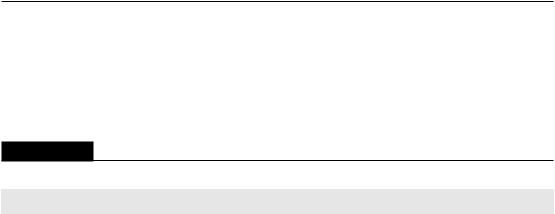
Part II: Working with Formulas and Functions
Note
If your data is in the form of a table, you can use autofiltering to accomplish many counting and summing operations. Just set the autofilter criteria, and the table displays only the rows that match your criteria (the nonqualifying rows in the table are hidden). Then you can select formulas to display counts or sums in the table’s total row. See Chapter 5 for more information on using tables. n
TABLE 13.1
|
Excel Counting and Summing Functions |
Function |
Description |
|
|
COUNT |
Returns the number of cells that contain a numeric value. |
|
|
COUNTA |
Returns the number of nonblank cells. |
|
|
COUNTBLANK |
Returns the number of blank cells. |
|
|
COUNTIF |
Returns the number of cells that meet a specified criterion. |
|
|
COUNTIFS* |
Returns the number of cells that meet multiple criteria. |
|
|
DCOUNT |
Counts the number of records that meet specified criteria; used with a worksheet database. |
|
|
DCOUNTA |
Counts the number of nonblank records that meet specified criteria; used with a worksheet |
|
database. |
|
|
DEVSQ |
Returns the sum of squares of deviations of data points from the sample mean; used pri- |
|
marily in statistical formulas. |
|
|
DSUM |
Returns the sum of a column of values that meet specified criteria; used with a worksheet |
|
database. |
|
|
FREQUENCY |
Calculates how often values occur within a range of values and returns a vertical array of |
|
numbers. Used only in a multicell array formula. |
|
|
SUBTOTAL |
When used with a first argument of 2, 3, 102, or 103, returns a count of cells that com- |
|
prise a subtotal; when used with a first argument of 9 or 109, returns the sum of cells that |
|
comprise a subtotal. |
|
|
SUM |
Returns the sum of its arguments. |
|
|
SUMIF |
Returns the sum of cells that meet a specified criterion. |
|
|
SUMIFS* |
Returns the sum of cells that meet multiple criteria. |
|
|
SUMPRODUCT |
Multiplies corresponding cells in two or more ranges and returns the sum of those products. |
|
|
SUMSQ |
Returns the sum of the squares of its arguments; used primarily in statistical formulas. |
|
|
SUMX2PY2 |
Returns the sum of the sum of squares of corresponding values in two ranges; used primar- |
|
ily in statistical formulas. |
|
|
SUMXMY2 |
Returns the sum of squares of the differences of corresponding values in two ranges; used |
|
primarily in statistical formulas. |
|
|
SUMX2MY2 |
Returns the sum of the differences of squares of corresponding values in two ranges; used |
|
primarily in statistical formulas. |
|
|
* These functions were introduced in Excel 2007.
282
